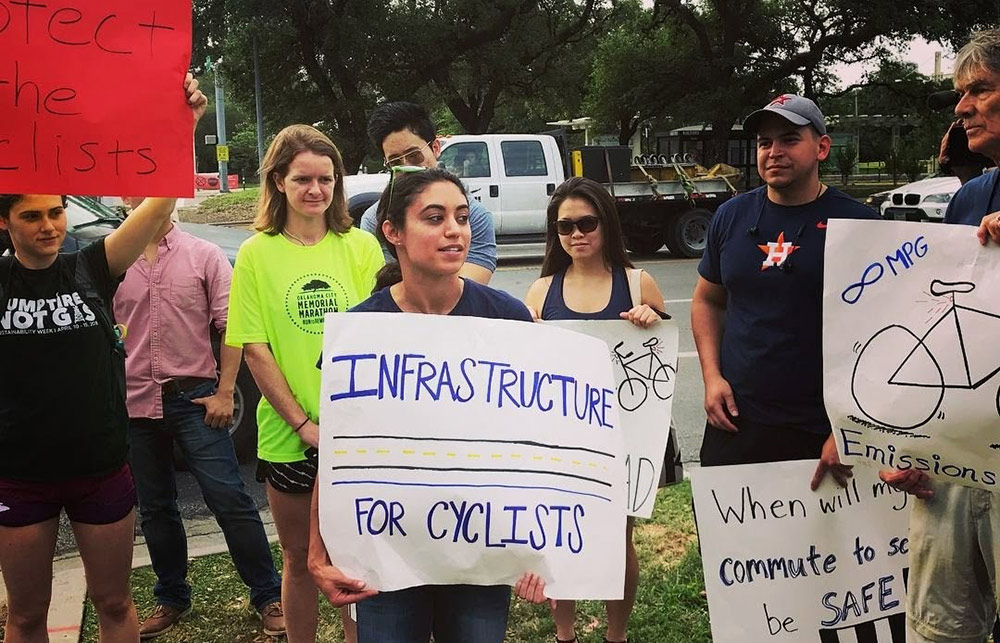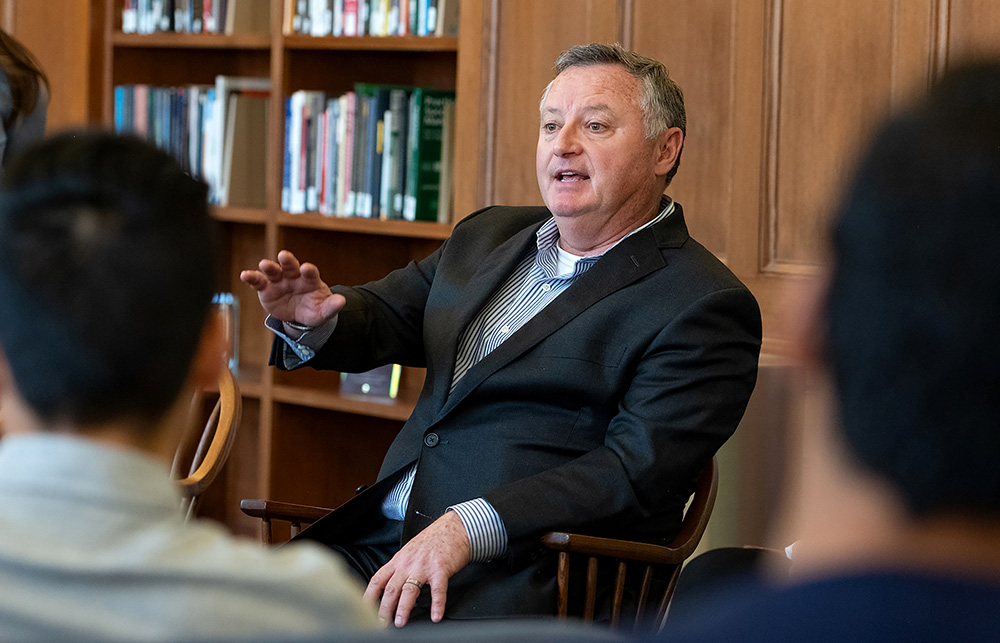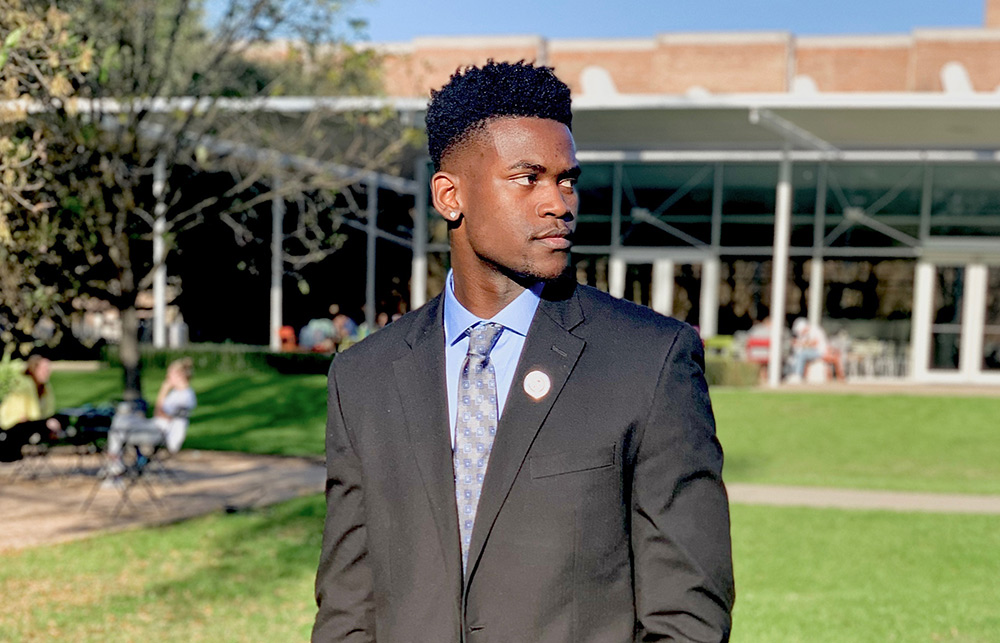当莱斯大学(Rice University)多尔新领导研究所(Doerr Institute for New Leaders)的主任汤姆•科尔迪茨问玛丽•纳托利愿不愿意接受领导力培训时,她颇为吃惊。玛丽是莱斯大学自行车和铁人三项俱乐部的新主席,刚刚组织了一场示威活动,呼吁有关部门改善学校周边一个危险十字路口的安全状况。最近,一名博士后的妻子在那里骑车时不幸丧生。“这是我第一次组织这种活动。”她说,“但最后有很多人参与,新闻媒体也进行了大量报道。”
这也是促使科尔迪茨为纳托利提供培训机会的原因。如果莱斯大学有学生为了某项事业开始展开行动,多尔研究所通常会联系他们,问他们是否需要专业的领导力教练。“我们不太在乎他们的事业是什么。”科尔迪茨说,“可以是‘大学共和党’(the College Republicans),也可以是‘黑人的命也是命’(Black Lives Matter)。”——参加这两个运动的学生都接受过培训,“几乎任何事业都可以。对我们来说,重点是培养卓越的领导者。”活动分子大有前途,因为“他们都对自己的事业充满激情,更好培训。”

尤其是在这个全世界都迫切需要优秀领导力的时候,多尔研究所的工作更值得关注。美国大学里,它显然是独一无二的,这是一个不依附于商学院或任何特定院系的领导力组织,为所有学生提供免费服务。教练都是休斯顿地区经过认证的专业人士,他们的合作对象可能也包括埃克森(Exxon)或壳牌(Shell)的高管。“我们从不说不。”科尔迪茨说。“就算我们有500名学生,我们也会找到教练,给他们培训。”
研究所是曾经在早期投资过亚马逊(Amazon)、谷歌(Google)和其他一些科技巨头的硅谷传奇风投家约翰•多尔和他妻子安的想法,他们都在莱斯大学读了电子工程的本科和研究生。其中一部分原因是想给母校提供帮助。安说:“莱斯大学毕业生担任公司领导的并不多。”但他们同时也在关注一个更大的问题。安说,在硅谷,“领导能力匮乏是企业发展面临的一个重要问题。”因此,他们给莱斯大学捐了5000万美元(这是该校收到的最大一笔捐赠),开展领导力培养项目。
杜尔夫妇找的猎头公司推荐了科尔迪茨当项目主任,他是一位退休的陆军准将,拥有心理学博士学位,曾经在西点军校负责领导力培养的研究和教学工作。后来,他去了耶鲁大学管理学院负责领导力培养项目。

约翰•多尔写了一本书,名叫《衡量什么是重要的》(Measure What Matters),所以也就不奇怪多尔研究所为什么会沉迷于衡量项目的培训结果。“汤姆总是想弄明白他做的事成没成功。”安安•多尔说。“他会不断衡量、检验自己在做的事。”每一个莱斯大学的新生都要填写领导力调查问卷(这是衡量领导力的常用方法),等到毕业时还要再填一遍。
参与了研究所项目的毕业生的分数往往会翻倍。但是其他学生“根本没有提高”,科尔迪茨说。其他学校的结果也差不多。“很多学校在使命宣言中都会提到领导力,但它们什么都没有做。从这可以看出,对每年招聘220万大学毕业生的美国公司而言,领导能力有多糟糕。没有公司想招一个只有高中生领导才能的大学毕业生。”
研究所不强迫学生参加领导力培训;只有30%到40%的学生会接受培训。即便是研究所主动联系的活动分子,也不是每个人都欣然应允。部分原因是大多数学生不知道这是一种什么培训,也不完全明白这是免费服务。纳托利回忆道:“我听说过领导力培训,但当时我觉得我没有时间干这个。”当机会摆在我面前时,“我心里想的是,你想从我这里得到什么?结果证明,真的只是为了我好。”
另一名学生蒂姆•哈里森弄在明白了培训是怎么回事后也报名了。“我听说过有培训,但一开始我并不知道是什么培训。”他说,“但在我做功课的过程中,越来越觉得,‘哇,他们免费提供培训。对我来说,想都不用想我就决定要参加。’”

尤其是上了大四,能接受教练的培训让他格外高兴。除了上课之外,“我还是一级学生运动员”——篮球前锋——“我还出任了黑人男性领导力倡议(Black Male Leadership Initiative)的主席,还在网上有一摊生意(家具翻新)。”他意识到,“与其幻想事情能变简单,还不如希望自己变得更好。”在这一点上,“我真的很依赖我的领导力教练。”哈里森今年5月毕业,获得了心理学学位,秋天将去埃森哲工作。
该研究所成立四年来,总结出了一些道理。“活动分子生活中基本上从来没有在任何事情上失败过,但他们需要帮助。”科尔迪茨说,“很多人都有冒名顶替综合症”——长期自我怀疑,“对失败非常恐惧。”
此外,许多人,有学生也有其他人,都很难理解研究所的运作模式,尽管其实非常简单。“我们把学生当成客户。”科尔迪茨说。“他们才是掌舵者。我们不会告诉学生他们需要学什么。我们会问他们的目标是什么,我们能怎么帮助他们。”在周围都是权威人士的大学环境中,这种方式会让人晕头转向。“往往在第一次训练结束后,他们会问教练:‘我做得怎么样?’我们会说:‘你还没有明白,你才是老板。’”
蒂姆•哈里森正在接受由科尔迪茨提供的领导力培训师的认证课程,后者正在筹备一个以培训为基础的非营利组织。两年前,玛丽•纳托利在那个危险的十字路口组织了示威。两年后,她说:“这不完全是我的功劳。很多团队都付出了巨大努力。但是,由于人们大量采取行动,呼吁提升安全,这个十字路口刚刚完成了一项耗资100万美元的修缮项目,配上了各种各样新的安全设施。”今年5月,她获得了生物工程博士学位,现在是博士后,带领团队开发新冠病毒即时诊断。她说:“多尔研究所的辅导给我今天的工作带来了很大帮助。”
多尔和科尔迪茨希望看到更多这样的成功故事。“我们一直希望研究所能成为一个测试案例,促使其他大学思考自己在领导力培训中的角色。”安•多尔说。科尔迪茨正在帮助卡耐基教学促进基金会(Carnegie Foundation for the Advancement of Teaching)为满足领导力教育特定标准的学院和大学设立一个特别项目。“这将带来很多变化。”他说,还能激励各所学校在那些令人振奋的使命宣言背后采取实质性动作。
他说:“我们想把我们学到的东西都推广出去,送出去,这样其他大学就可以改变自己在领导力培养领域的态度。”学生们对此显然很有热情,但学校能否抓住这个机会还有待观察。(财富中文网)
译者:Feb
当莱斯大学(Rice University)多尔新领导研究所(Doerr Institute for New Leaders)的主任汤姆•科尔迪茨问玛丽•纳托利愿不愿意接受领导力培训时,她颇为吃惊。玛丽是莱斯大学自行车和铁人三项俱乐部的新主席,刚刚组织了一场示威活动,呼吁有关部门改善学校周边一个危险十字路口的安全状况。最近,一名博士后的妻子在那里骑车时不幸丧生。“这是我第一次组织这种活动。”她说,“但最后有很多人参与,新闻媒体也进行了大量报道。”
这也是促使科尔迪茨为纳托利提供培训机会的原因。如果莱斯大学有学生为了某项事业开始展开行动,多尔研究所通常会联系他们,问他们是否需要专业的领导力教练。“我们不太在乎他们的事业是什么。”科尔迪茨说,“可以是‘大学共和党’(the College Republicans),也可以是‘黑人的命也是命’(Black Lives Matter)。”——参加这两个运动的学生都接受过培训,“几乎任何事业都可以。对我们来说,重点是培养卓越的领导者。”活动分子大有前途,因为“他们都对自己的事业充满激情,更好培训。”
尤其是在这个全世界都迫切需要优秀领导力的时候,多尔研究所的工作更值得关注。美国大学里,它显然是独一无二的,这是一个不依附于商学院或任何特定院系的领导力组织,为所有学生提供免费服务。教练都是休斯顿地区经过认证的专业人士,他们的合作对象可能也包括埃克森(Exxon)或壳牌(Shell)的高管。“我们从不说不。”科尔迪茨说。“就算我们有500名学生,我们也会找到教练,给他们培训。”
研究所是曾经在早期投资过亚马逊(Amazon)、谷歌(Google)和其他一些科技巨头的硅谷传奇风投家约翰•多尔和他妻子安的想法,他们都在莱斯大学读了电子工程的本科和研究生。其中一部分原因是想给母校提供帮助。安说:“莱斯大学毕业生担任公司领导的并不多。”但他们同时也在关注一个更大的问题。安说,在硅谷,“领导能力匮乏是企业发展面临的一个重要问题。”因此,他们给莱斯大学捐了5000万美元(这是该校收到的最大一笔捐赠),开展领导力培养项目。
杜尔夫妇找的猎头公司推荐了科尔迪茨当项目主任,他是一位退休的陆军准将,拥有心理学博士学位,曾经在西点军校负责领导力培养的研究和教学工作。后来,他去了耶鲁大学管理学院负责领导力培养项目。
约翰•多尔写了一本书,名叫《衡量什么是重要的》(Measure What Matters),所以也就不奇怪多尔研究所为什么会沉迷于衡量项目的培训结果。“汤姆总是想弄明白他做的事成没成功。”安安•多尔说。“他会不断衡量、检验自己在做的事。”每一个莱斯大学的新生都要填写领导力调查问卷(这是衡量领导力的常用方法),等到毕业时还要再填一遍。
参与了研究所项目的毕业生的分数往往会翻倍。但是其他学生“根本没有提高”,科尔迪茨说。其他学校的结果也差不多。“很多学校在使命宣言中都会提到领导力,但它们什么都没有做。从这可以看出,对每年招聘220万大学毕业生的美国公司而言,领导能力有多糟糕。没有公司想招一个只有高中生领导才能的大学毕业生。”
研究所不强迫学生参加领导力培训;只有30%到40%的学生会接受培训。即便是研究所主动联系的活动分子,也不是每个人都欣然应允。部分原因是大多数学生不知道这是一种什么培训,也不完全明白这是免费服务。纳托利回忆道:“我听说过领导力培训,但当时我觉得我没有时间干这个。”当机会摆在我面前时,“我心里想的是,你想从我这里得到什么?结果证明,真的只是为了我好。”
另一名学生蒂姆•哈里森弄在明白了培训是怎么回事后也报名了。“我听说过有培训,但一开始我并不知道是什么培训。”他说,“但在我做功课的过程中,越来越觉得,‘哇,他们免费提供培训。对我来说,想都不用想我就决定要参加。’”
尤其是上了大四,能接受教练的培训让他格外高兴。除了上课之外,“我还是一级学生运动员”——篮球前锋——“我还出任了黑人男性领导力倡议(Black Male Leadership Initiative)的主席,还在网上有一摊生意(家具翻新)。”他意识到,“与其幻想事情能变简单,还不如希望自己变得更好。”在这一点上,“我真的很依赖我的领导力教练。”哈里森今年5月毕业,获得了心理学学位,秋天将去埃森哲工作。
该研究所成立四年来,总结出了一些道理。“活动分子生活中基本上从来没有在任何事情上失败过,但他们需要帮助。”科尔迪兹说,“很多人都有冒名顶替综合症”——长期自我怀疑,“对失败非常恐惧。”
此外,许多人,有学生也有其他人,都很难理解研究所的运作模式,尽管其实非常简单。“我们把学生当成客户。”科尔迪茨说。“他们才是掌舵者。我们不会告诉学生他们需要学什么。我们会问他们的目标是什么,我们能怎么帮助他们。”在周围都是权威人士的大学环境中,这种方式会让人晕头转向。“往往在第一次训练结束后,他们会问教练:‘我做得怎么样?’我们会说:‘你还没有明白,你才是老板。’”
蒂姆•哈里森正在接受由科尔迪兹提供的领导力培训师的认证课程,后者正在筹备一个以培训为基础的非营利组织。两年前,玛丽•纳托利在那个危险的十字路口组织了示威。两年后,她说:“这不完全是我的功劳。很多团队都付出了巨大努力。但是,由于人们大量采取行动,呼吁提升安全,这个十字路口刚刚完成了一项耗资100万美元的修缮项目,配上了各种各样新的安全设施。”今年5月,她获得了生物工程博士学位,现在是博士后,带领团队开发新冠病毒即时诊断。她说:“多尔研究所的辅导给我今天的工作带来了很大帮助。”
多尔和科尔迪茨希望看到更多这样的成功故事。“我们一直希望研究所能成为一个测试案例,促使其他大学思考自己在领导力培训中的角色。”安•多尔说。科尔迪茨正在帮助卡耐基教学促进基金会(Carnegie Foundation for the Advancement of Teaching)为满足领导力教育特定标准的学院和大学设立一个特别项目。他说:“这将带来很多变化。”他说,还能激励各所学校在那些令人振奋的使命宣言背后采取实质性动作。
他说:“我们想把我们学到的东西都推广出去,送出去,这样其他大学就可以改变自己在领导力培养领域的态度。”学生们对此显然很有热情,但学校能否抓住这个机会还有待观察。(财富中文网)
译者:Feb
Mary Natoli was surprised when Tom Kolditz, director of Rice University’s Doerr Institute for New Leaders, asked if she would like leadership coaching. She was the new president of Rice’s Cycling and Triathlon Club and had recently organized a demonstration to improve safety at a dangerous intersection near the campus; the wife of a postdoctoral student had recently been killed there while cycling. “It was the first time I had done something like that,” she recalls, “but it ended up getting a lot of news coverage and a lot of attendees.”
That’s what prompted Kolditz to offer coaching to Natoli. When Rice students step forward to take action for a cause, the Doerr Institute generally contacts them to ask if they’d like a professional leadership coach. “We don’t care that much about what their cause is,” says Kolditz. “It could be the College Republicans or Black Lives Matter”—both of which have received coaching—“or almost anything else. For us it’s about producing incredible leaders.” Activists are especially promising because “they’re all passionate about their cause, which makes them easy to train.”
At a time when the world is crying out for leadership, the Doerr Institute merits attention. It’s apparently unique in the world of U.S. universities, a leadership organization untethered to the business school or any specific department, offering services free of charge to all students. The coaches are certified professionals in the Houston area who might also be working with Exxon or Shell executives. “We never say no,” says Kolditz. “If we have 500 students, we find the coaches and we do it.”
The institute was the idea of legendary Silicon Valley venture capitalist John Doerr, who backed Amazon, Google, and other tech colossi in their early days, and his wife, Ann, both of whom hold bachelor’s and master’s degrees in electrical engineering from Rice. Partly they wanted to help their alma mater. “There are not that many companies being led by Rice graduates,” Ann notes. But they also focused on a larger problem. In Silicon Valley, “one of the things that’s an issue for companies to grow is just leadership capacity and the lack thereof,” she says. So they gave Rice $50 million, the largest gift the school has ever received, to establish a leadership development program.
A headhunter the Doerrs engaged to find the program’s director recommended Kolditz, a retired Army brigadier general with a Ph.D. in psychology who oversaw research and teaching of leadership development at West Point. He later directed the leadership development program at the Yale School of Management.
John Doerr wrote a book called Measure What Matters, so it’s no surprise that the Doerr Institute measures its results obsessively. “Tom is always trying to understand if he’s doing something that's successful,” says Ann Doerr. “He's always measuring and testing what he's doing.” Every new Rice student completes a leadership identity questionnaire, a widely used measure of leadership capacity, and completes it again at graduation.
Those who work with the institute typically double their score. But the rest “don’t improve at all,” says Kolditz. Results at other schools are similar. “Most schools have something about leadership in their mission statements, but they don’t do anything. It underscores how dismal leadership is for companies that are hiring 2.2 million college grads every year. No company wants to hire a college graduate with high school leadership skills.”
The institute doesn’t require anyone to use its services; 30% to 40% of students do so. Even the activists whom the institute contacts don’t always say yes. That’s partly because most students have no idea what this kind of coaching is and don’t fully understand that it’s a free service. “I had heard of the leadership coaching, but I thought it was something I didn’t have time for,” Natoli recalls. When offered the opportunity, “I was like, what do you want from me? And it turned out it was really just for my benefit.”
Another student, Tim Harrison, signed up once he understood the deal. “I’d heard there was coaching, and at first I didn’t really know what coaching was,” he says. “But the more I looked into it, I was like, 'Wow, they’re offering this for free. For me it was an absolute no-brainer.’”
He was especially glad to have a coach when he entered his senior year. In addition to classes, “I was a Division 1 student athlete”—basketball, a forward—“and I became president of the Black Male Leadership Initiative, and I was running an online business [flipping furniture].” He realized that “instead of wishing it was easier, I’ve got to wish I was better.” For that, “I really relied on my leadership coach.” Harrison graduated in May with a psychology degree and will go to work for Accenture in the fall.
The institute has learned a few things in its four years of existence. “The activists have typically never failed at anything in their lives, yet they want some help,” says Kolditz. “We have to manage a lot of impostor syndrome”—chronic self-doubt—“and fear of failure.”
In addition, many people, both students and others, struggle to grasp the institute’s operating model, simple though it is. “We treat students like clients,” Kolditz says. “They’re in the driver’s seat. We don’t tell students what they need to learn. We ask what their goals are and how we can help.” That’s disorienting in a university setting where authority figures surround students. “After their first session, they often turn to the coach and say, ‘How’d I do?’ We say, ‘You don’t get it yet—you’re the boss.’”
Tim Harrison is in the process of being certified as a leadership coach and is being coached by Kolditz as he develops a coaching-based nonprofit. Two years after Mary Natoli held her demonstration at the dangerous intersection, she says, “It’s not entirely due to me at all. It was a huge effort with a lot of groups. But as a result of a number of actions and people advocating for safety, the intersection is just finishing up a $1 million improvement project with all kinds of new safety features.” She got her Ph.D. in bioengineering in May and is now in a postdoctorate role coleading a team developing a point-of-care COVID diagnostic. She says, “The Doerr Institute coaching is really helping me now.”
The Doerrs and Kolditz want more such success stories. “We always wanted this to be a test case for other universities to think about their role in leadership training,” says Ann Doerr. Kolditz is helping the Carnegie Foundation for the Advancement of Teaching create a designation for colleges and universities that meet certain criteria for leadership education. “It’s going to cause a lot of change,” he says, incentivizing schools to put substance behind those uplifting mission statements.
“We want to give away everything we’ve learned, just give it away so other universities can improve their posture with respect to leader development,” he says. The passion among students is certainly there. Whether schools will seize the opportunity remains to be seen.






